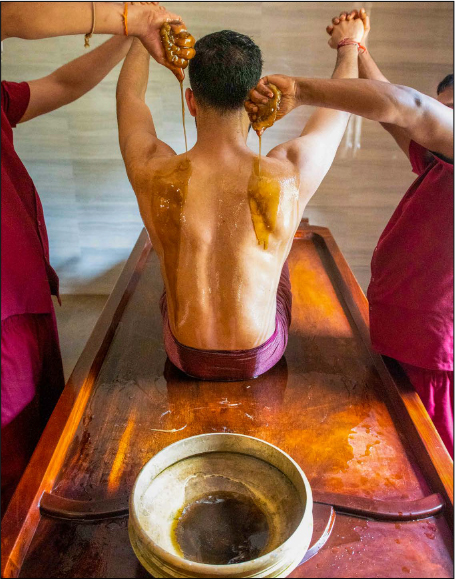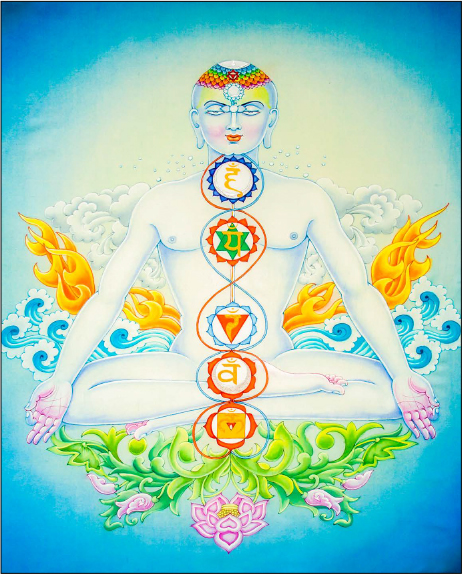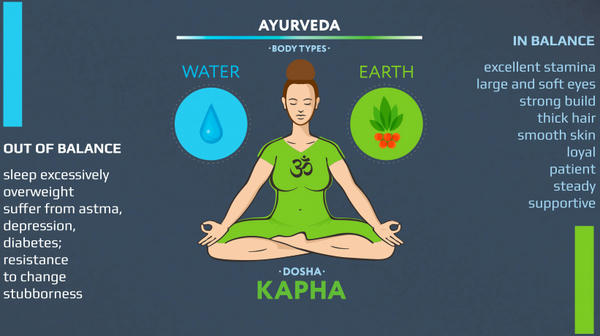Mantras & More§
The Role of Sound in Healing§
 N ADDITION TO OTHER ASPECTS OF AYURVEDA, EACH DOSHA HAS a specific bija mantra meant to bring the body back into balance. Typically, it is recommended to chant the bija mantra for at least fifteen minutes a day once the dosha imbalance has been identified. Start by chanting out loud and then, once it feels comfortable to do so, chant it silently in your mind. Continue to chant this mantra in your practice until the symptoms of dosha imbalance resolve. For example, this will be apparent when the qualities of a vata dosha feel more grounded, when those of a pitta dosha feel cooled down or when someone who has balanced a kapha dosha feels more stimulated. Once this occurs, revert back to the chakra mantra (explained on page 46), which is great for keeping all of the doshas in maintenance. The bija mantras for the doshas are a correction for an acute issue in the short term, whereas the chakra mantra is a form of long-term maintenance.§
N ADDITION TO OTHER ASPECTS OF AYURVEDA, EACH DOSHA HAS a specific bija mantra meant to bring the body back into balance. Typically, it is recommended to chant the bija mantra for at least fifteen minutes a day once the dosha imbalance has been identified. Start by chanting out loud and then, once it feels comfortable to do so, chant it silently in your mind. Continue to chant this mantra in your practice until the symptoms of dosha imbalance resolve. For example, this will be apparent when the qualities of a vata dosha feel more grounded, when those of a pitta dosha feel cooled down or when someone who has balanced a kapha dosha feels more stimulated. Once this occurs, revert back to the chakra mantra (explained on page 46), which is great for keeping all of the doshas in maintenance. The bija mantras for the doshas are a correction for an acute issue in the short term, whereas the chakra mantra is a form of long-term maintenance.§
The healing power of mantras and sound is inextricably woven into ayurvedic medicine. Mantras are a vehicle for raising individual consciousness to universal consciousness while also reversing both mental and physical disorders. Bija mantras are a potent way to alter the body. Therefore, they are a crucial part of the prescription when helping a patient to balance the doshas.§
Just as important, mantras also once played a fundamental role in the preparation of medicine. Traditionally, the entire process was, in fact, inseparable from sound. In training to be an ayurvedic doctor, the student would first live with his teacher and engage in a committed mantra practice meant to enliven the consciousness of the aspiring physician. When the guru deemed his student receptive enough to imbibe the knowledge of ayurvedic medicine, he would begin to plant the seeds for the ayurvedic herbs—chanting a specific mantra for each one. When the herbs were harvested, another mantra was engaged; these mantras were chanted yet again while the herbs were administered to patients.§
Over the last several hundred years, however, as ayurvedic medicine has become more popular and institutionalized in India, it has been taught using methods akin to Western medicine. Sadly, modern life does not allow for the long, intensive training once required to be an ayurvedic practitioner; there are only a few people left in the world who are taught in the classic way.§
Thanks to my childhood mantra practice, I have inadvertently approached the study of ayurveda in the traditional way. Because of this early exposure to mantra meditation, its profound influence in ayurveda was a natural connection for me to make as I shifted my neurology practice toward integrative medicine. Most modern-day ayurvedic physicians, however, have not been raised with a mantra meditation practice and therefore don’t have a full appreciation for the important role it plays in this system. Over time, the discipline has become less holistic. In general, mantras are no longer used during the preparation of the herbs—today they are processed in factories. Ironically, many modern ayurvedic physicians focus mainly on physical complaints, dismissing mental and spiritual complaints as irrelevant to their practice. Sadly, when mantra practice is not used to purify and equip the mind of the healer and strengthen the effect of the herbs, and is not included as part of the prescription for patients, the benefit is not nearly as effective.§
Psychological conditions, in particular, are much more difficult to cure through herbs and diet alone. Returning to the ancient traditions of sound in ayurvedic medicine is essential to the efficacy of this discipline. Without it, it is impossible to understand the full nature of the human body or its ultimate goal of attaining access to the higher consciousness, and energy, of Brahman. To that end, we must turn to the earliest notions of sound within ayurvedic medicine and explore the ancient philosophy of sound as a form of yoga as I do in my book, Sound Medicine.§
A Mantra for Balancing the Chakras§
I was taught a chakra mantra by Sri Sakthi Amma. It is unique in that it combines all of the bija mantras for the chakras with another mantra, Om Namah Shivaya—with the aim of creating a connection to the universal consciousness through the five elements that serve as the building blocks for the material world (ether, air, fire, water and earth). When the mantras are combined in this way, they create a powerful alchemy for a specific purpose—which, here, is to uniformly move energy through all of the chakras, clearing out obstructions to health while also bringing the body into closer participation with the universal energy field.§
THE BIJA MANTRAS FOR THE CHAKRAS§
Root Chakra§ |
(mūlādhāra)§ |
La |
Sacral Chakra§ |
(svādiś |
Va |
Solar Plexus Chakra§ |
(ma |
Ra |
Heart Chakra§ |
(ānāhata)§ |
Ya |
Throat Chakra§ |
(viśuddha)§ |
Ha |
Third Eye Chakra§ |
(ājñā)§ |
O |
Crown Chakra§ |
(sahasrāra)§ |
O |
SRI SAKTHI AMMA’S CHAKRA MANTRA§
In a most subtle way, the chakra bija mantras combine with the sacred mantra Om Namah Śivaya, in that the first bija of each pair (in bold) is one syllable of the mantra.§
HARE O §
§
NA , LA
, LA §
§
MA , VA
, VA §
§
ŚI , RA
, RA §
§
VA , YA
, YA §
§
YA , HA
, HA §
§
ŚIVA OM§
SWĀHĀ§
PRACTICE§
Chant this mantra aloud for ten minutes for three days, fifteen minutes for the next ten days, and then twenty minutes each day thereafter. Once it becomes familiar, you may chant it silently.§
Always chant the entire mantra, in order to disseminate energy equally throughout the body. I do not recommend chanting a single bija mantra—if, for example, you want only to activate the throat chakra—because this can build up disproportionate heat in one area and cause an imbalance.§
For those interested in hearing the version of the chakra mantra that my husband and I recorded, you can find it on my website: drkulreetchaudhary.com.§
Natural healing: (left) patient at the Sri Narayani Holistic Centre in Vellore, India, is bathed with oils, an important part of the extensive remedies; (right) artist’s depiction of the chakras, with ether, air, fire, water and earth depicted behind; (below, left) healer palpates a patient’s forehead to energize the nervous system§
Kapha Dosha§
 HE QUALITIES OF KAPHA ARE HEAVY, STEADY, SLOW, COLD, SOFT and solid. Kapha individuals, consequently, tend to have a slow metabolism, shun exercise, and gain weight easily. They have large physical frames but with well-developed muscles and joints. Physically, kaphas have a great deal of strength, stamina and endurance. They learn slowly but their long-term memory is excellent. They tend to be deep sleepers and often have trouble waking up in the morning.§
HE QUALITIES OF KAPHA ARE HEAVY, STEADY, SLOW, COLD, SOFT and solid. Kapha individuals, consequently, tend to have a slow metabolism, shun exercise, and gain weight easily. They have large physical frames but with well-developed muscles and joints. Physically, kaphas have a great deal of strength, stamina and endurance. They learn slowly but their long-term memory is excellent. They tend to be deep sleepers and often have trouble waking up in the morning.§
When kapha types are in balance, they tend to be generous, have loving personalities, and remain stable and grounded in the midst of chaos—they are like the eye of a hurricane. Oprah Winfrey strikes me as a kapha in this way. When kapha individuals get out of balance, however, they can experience greed, possessiveness and lethargy. The key to keeping kapha in balance is to stay mentally and physically stimulated.§
Kapha individuals are more likely to have diseases connected to the water principle, such as flu, sinus congestion, excess mucus production, obesity, diabetes, water retention and headaches. Winter and spring are the seasons when kapha accumulates most in the body, and spring is an ideal time for seasonal detoxification programs, because kapha begins to “thaw” as the temperature gets warmer, and toxins are ready to be released from the body.§
There are two warm and stimulating bija mantras that help to balance the kapha dosha. Hum (pronounced hoom) stimulates energy throughout the body, from the digestive tract to the immune system to the brain. Dum (pronounced doom) is, despite its phonetic spelling, intended to create protective energy, spiritually and physically.§



 hāna)
hāna) ipūra)
ipūra)

